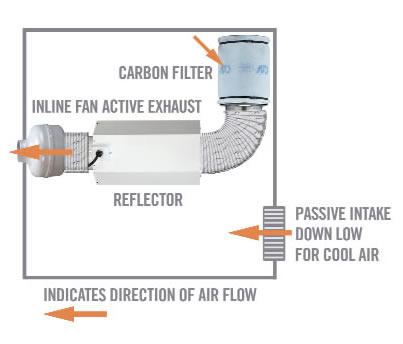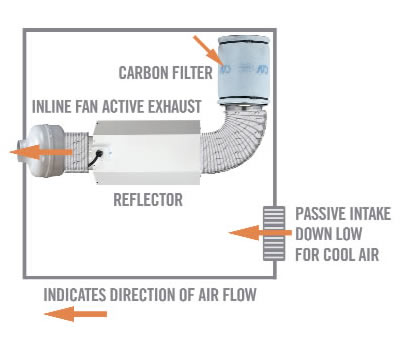When gardening indoors it is important to remember that ?plants need certain conditions to function properly and reach the fullest of their potentials. Here we look at the importance of air exchange when growing indoors.
 Air exchange in a grow room is one of the most important environmental factors that you must have firm control of. For plants to photosynthesis and grow they need constant air exchange to refresh the CO2 content of the surrounding air during both day and night periods. In a stagnant air environment a plant can use up the CO2 surrounding a leaf within 20 minutes.
Air exchange in a grow room is one of the most important environmental factors that you must have firm control of. For plants to photosynthesis and grow they need constant air exchange to refresh the CO2 content of the surrounding air during both day and night periods. In a stagnant air environment a plant can use up the CO2 surrounding a leaf within 20 minutes.
Air is exchanged through holes in the leaf surface called stomata which also facilitates the loss of water through the leaves (transpiration). Carbon dioxide is taken in through the stomata while oxygen is released as a by-product of photosynthesis. (6CO2 +12H2O + Light Energy ~ C6H12O6 + O2). The lack of CO2 will slow down or even stop the process of photosynthesis, just as the addition of CO2 to the atmosphere will increase the rate of photosynthesis.
Air exchange in the grow room is also crucial for keeping control over temperature and humidity. Lack of air exchange in this aspect will result in a constant increase in temperature as the radiant heat from the lights will just accumulate. Humidity of the grow room will also constantly rise due to transpiration from the plants if air exchange is not adequate.
?There is an alternative to pumping air in and out of a grow room but this involves the use of CO2 burners or canisters, air conditioning units and dehumidifiers in a sealed room. This is generally a much more expensive way of running a grow room but can be very beneficial in regards to overall environmental control which makes them much more popular in hotter countries where outdoor temperatures are warmer than the desired indoor temperature. Running a sealed room also stops any unwanted pests or pathogens from entering your room which can also be even more prevalent in warmer countries.
Air movement is an important factor that will not only help your plants to breathe but will also help to strengthen the stems of your plants if the movement is vigorous enough. This response is known as thigmomorphogenesis which is linked to thigmotropism (a plants response to touch). A plant’s response to being moved around is to strengthen itself to avoid any more movement that could be damaging. This creates stronger stems/branches which can therefore hold a greater weight of produce before they bow or snap; leading to a lesser requirement for additional support.
Exposing younger plants/seedlings to air movement can give them the structural integrity they need to support themselves. Too vigorous movement of young plants can cause snapping and lead to plants dying so finding the perfect medium of air movement is key. As long as plants are moving they are being strengthened… Too much air movement can be detrimental to mature plants if leaf surfaces are cooled too much as leaves can curl up, reducing the amount of active photosynthetic material on the leaf. Vigorous air movement can cause stomata to close as plants try to prevent water loss which will stop the exchange of oxygen and carbon dioxide, leading to reduced or stopped photosynthesis.
Air movement is also a good idea to remove any residual condensation created through transpiration. Leaves sat on top of one another can trap moisture from transpiration which can cause a reduced uptake of water and can even lead to other detrimental effects caused by localised high humidity. Unwanted grow room pests are also deterred by strong air movement which hinders a lot of species’ reproductive cycles and disturbs their habitat, making it a much less desirable home for them.
Mr Sativa





Comments (2)